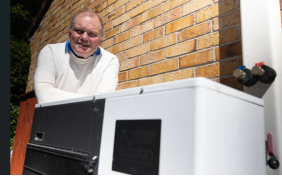New DATA reveals environmental impact of Santa’s journey

As drivers are making conscious decisions to reduce their level of emissions, even Santa needs to start making positive choices to avoid the climate crisis!
While reindeer may be a greener alternative to the petrol passenger vehicle, which accounts for 61% of total EU road transport emissions, Santa may have to electrify his processes if he really wants longevity in this toymaking and transport game.
Conscious of his sleigh’s energy needs on THE most important night of the year, could modifications to Santa’s sleigh help Rudolph and the rest of the gang reduce their carbon hoof-print?
Dover Fueling Solutions (DFS) investigates further. Saddle up Santa and stick the electric motor into drive!
An EV Merry Christmas
Now, we all know Santa’s reindeer do most of the flying and his magic, through Christmas spirit from the world’s children, powers his journey, but imagine the sleigh was powered by petrol…
New data from DFS reveals the true environmental impact of Santa’s trip on 24th December – when the typical petrol vehicle for instance emits around 4.6 metric tons of CO2 per year.
Looking at alternative fuels and the charging options available, DFS has calculated exactly how much time is needed for Saint Nick to deliver presents across Europe on his international mission.
Remarkably, there will be over 197 million households covered by Santa’s colossal toy-delivery schedule in Europe alone. The highest volume of drops will fall in Germany, France, and Italy with 41.039 million, 31.059 million, and 18.866 million private households respectively. Travelling the length and breadth of the continent in his shiny new electric vehicle, that’s 10,180,000 square kilometres to be exact. With that number of households, Santa will need to take roughly 0.0002 seconds per household to fulfil all of his deliveries within a standard 12-hour shift.
In contrast, the average petrol vehicle has a fuel tank between 45 and 65 litres. Assuming Santa’s fuel tank sits at 65 litres, he will produce 150.15 kg of CO2 with every full tank. Over a full-tank radius of 600 kilometres, that’s 0.4 kg of C02 produced per kilometre. In covering all 10,180,000 sq km of Europe, Santa would release a hefty 4.072 million kilograms of CO2 into the atmosphere if he chose a petrol-powered vehicle.
If Christmas spirit was to ever get dangerously low or the reindeer were tired and needed a break, wouldn’t it be convenient if the all-new electric sleigh kicked in to offer that little bit extra support?
Europe’s Charging Infrastructure
When Santa’s electric sleigh runs out of juice, he will have to drop down to street level and recharge but that shouldn’t be a problem. In 2021, the continent had an estimated 375,000 charging stations in place, however, the EU aims to have at least 3.4 million operational public charging points by 2030. This is all part of a massive upgrade of the continent’s infrastructure, which may cumulatively cost over 240 billion euro. Clearly, this will make Santa’s job easier and spare him any (further) grey hairs.
The European peninsula measures 2,154km wide, and a good electric vehicle battery is typically able to offer a 500-kilometre range from a single charging cycle. From this, Santa would have to plug in at least four times to travel the full width of the continent while he would have to plug in 20,360 times to cover the full 10,180,00 sq kilometre area.
In fact, if Santa was to install a super-fast charging point at the North Pole, he could reduce delivery times to just 9 hours 45 minutes! His carbon emissions levels will be greener than a Christmas tree too, and he wouldn’t be facing costly EU sanctions on his toymaking operations.
Milk and Cookies
As Santa unloads his sack of presents, the research also points to the huge number of calories he consumes through numerous mince pies, cookies, and glasses of milk across Europe. Santa’s trip won’t only be fuelled by lithium-ion electric power and reindeer dust.
If we attribute two cookies to each household, that’s a whopping 394 million cookies consumed in addition to 197 million glasses of milk. Navigating the Netherlands could be a particularly calorific task with all that edam. Fortunately, the country has the most charging ports in Europe with over 37,000.
Santa may also have to invest in his own electric-powered exercise bike in the new year to burn off the calories from this night’s work!




